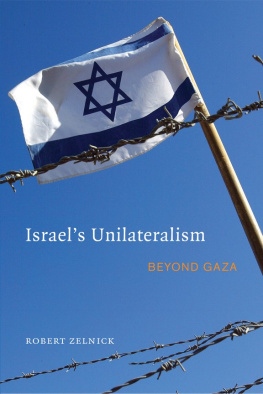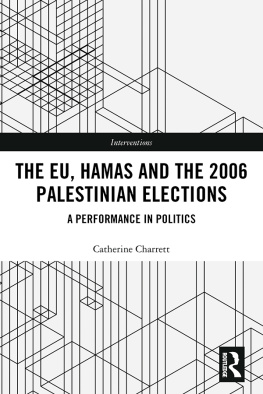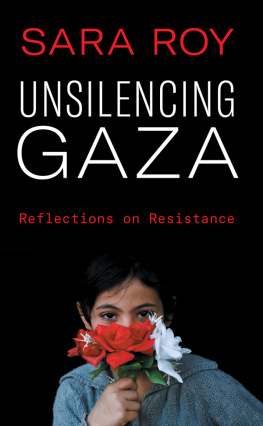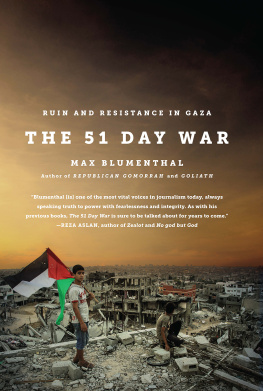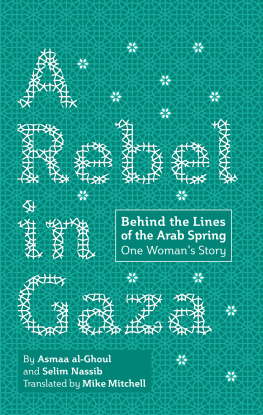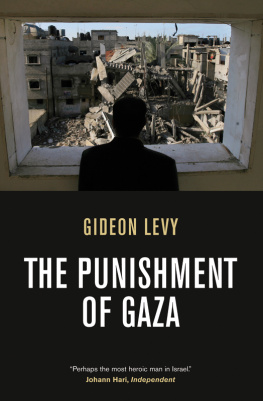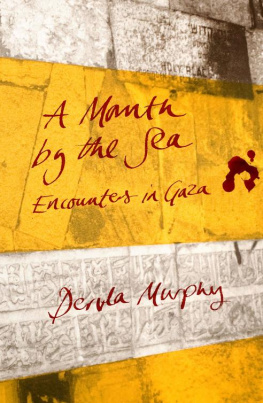Roy - Hamas and Civil Society in Gaza
Here you can read online Roy - Hamas and Civil Society in Gaza full text of the book (entire story) in english for free. Download pdf and epub, get meaning, cover and reviews about this ebook. year: 2011, publisher: Princeton University Press, genre: Politics. Description of the work, (preface) as well as reviews are available. Best literature library LitArk.com created for fans of good reading and offers a wide selection of genres:
Romance novel
Science fiction
Adventure
Detective
Science
History
Home and family
Prose
Art
Politics
Computer
Non-fiction
Religion
Business
Children
Humor
Choose a favorite category and find really read worthwhile books. Enjoy immersion in the world of imagination, feel the emotions of the characters or learn something new for yourself, make an fascinating discovery.
Hamas and Civil Society in Gaza: summary, description and annotation
We offer to read an annotation, description, summary or preface (depends on what the author of the book "Hamas and Civil Society in Gaza" wrote himself). If you haven't found the necessary information about the book — write in the comments, we will try to find it.
Roy: author's other books
Who wrote Hamas and Civil Society in Gaza? Find out the surname, the name of the author of the book and a list of all author's works by series.
Hamas and Civil Society in Gaza — read online for free the complete book (whole text) full work
Below is the text of the book, divided by pages. System saving the place of the last page read, allows you to conveniently read the book "Hamas and Civil Society in Gaza" online for free, without having to search again every time where you left off. Put a bookmark, and you can go to the page where you finished reading at any time.
Font size:
Interval:
Bookmark:

Hamas and Civil Society in Gaza
P RINCETON S TUDIES IN M USLIM P OLITICS
Dale F. Eickelman and Augustus Richard Norton, EDITORS
A list of titles in this series can be found at the back of the book.
Hamas and Civil Society in Gaza
E NGAGING THE
I SLAMIST S OCIAL S ECTOR
Sara Roy
PRINCETON UNIVERSITY PRESS
PRINCETON AND OXFORD
Copyright 2011 by Princeton University Press
Published by Princeton University Press, 41 William Street, Princeton, New Jersey 08540
In the United Kingdom: Princeton University Press, 6 Oxford Street,
Woodstock, Oxfordshire OX20 1TW
press.princeton.edu
All Rights Reserved
Library of Congress Cataloging-in-Publication Data
Roy, Sara.
Hamas and civil society in Gaza : engaging the Islamist social sector / Sara Roy.
p. cm. (Princeton studies in Muslim politics)
Includes bibliographical references and index.
ISBN 978-0-691-12448-3 (hardback)
1. Harakat al-Muqawamah al-IslamiyahPolitical aspectsGaza Strip. 2. Harakat
al-Muqawamah al-IslamiyahSocial aspectsGaza Strip. 3. Arab-Israeli conflict.
4. Islamic fundamentalismGaza Strip. 5. Jamiah al-Islamiyah (Gaza) I. Title.
HV6433.P25R69 2011
324.25695p308209531dc22 2010048465
British Library Cataloging-in-Publication Data is available
This book has been composed in Sabon
Printed on acid-free paper
Printed in the United States of America
13579108642
To Martha
It is not the consciousness of men that determines
their existence but their social existence that
determines their consciousness.
Karl Marx, A Contribution to the Critique
of Political Economy
CONTENTS
C HAPTER 1
Introduction: Structure, Arguments, and Conceptual Framework
C HAPTER 2
A Brief History of Hamas and the Islamic Movement in Palestine
C HAPTER 3
Islamist Conceptions of Civil Society
C HAPTER 4
The Evolution of Islamist Social Institutions in the Gaza Strip: Before and during Oslo (a Sociopolitical History)
C HAPTER 5
Islamist Social Institutions: Creating a Descriptive Context
C HAPTER 6
Islamist Social Institutions: Key Analytical Findings
C HAPTER 7
A Changing Islamist Order? From Civic Empowerment to Civic Regressionthe Second Intifada and Beyond
P OSTSCRIPT
The Devastation of GazaSome Additional Reflections on Where We Are Now
A PPENDIX
Islamist (and Non-Islamist) Social Institutions
T HIS BOOK ended very differently than it began. Along the way, many people and organizations have played an important role in its conceptualization, research, and writing, far more than I can or am permitted to name.
Among the people, I will just mention a notable few to whom I am greatly indebted. Foremost is the late Dr. Haidar Abdel Shafi, perhaps the only Palestinian leader who earned the respect and admiration of all factions and Palestinians overall. Years ago, when I needed help with access, I asked Dr. Haidar if he would help me contact some key Hamas officials. I understood that getting to these individuals on my own would not be easy, and that even if I managed to do so, it would take time. With his usual grace and kindness, Dr. Haidar agreed. He made two phone callsto the late Dr. Ismail Abu Shanab and to Ismail Haniyeh. Within twenty-four hours, I was sitting in their offices, after which additional doors were opened for me. For this, and for so much more, I will always be grateful to the late Dr. Haidar, my dear and cherished friend.
Other people who deserve special acknowledgement are Martha Myers, the late Ismail Abu Shanab, Prime Minister Ismail Haniyeh, Radwan Abu Shmais, Khaled Abu Zaid, Abu Hisham Saqallah, Ramadan (who did not want his last name used), Imad Abu Dayya, Augustus Richard Norton, Elaine Hagopian, Bruce Lawrence, Glenn Robinson, Irene Gendzier, Brigitte Schulz, Leticia Pena, and David Henley.
I am also indebted to the many Palestinians who met with me and allowed me in. They came from inside Hamas and the Islamic movement and outside itits members and nonmembers, supporters, non-supporters and detractors, employees and recipients, friends and enemies.
This book would not have been possible without a substantial research grant from the John D. and Catherine T. MacArthur Foundation. I am very grateful to the MacArthur Foundation for their support and for their continued understanding, especially with regard to the changing publication date of this manuscript.
I want to express my heartfelt gratitude to the faculty and staff of the Center for Middle Eastern Studies at Harvard University, which has been my academic home for over fifteen years. Here I want to acknowledge Roger Owen, Steven Caton, Herbert Kelman, Roy Mottehedeh, Susan Miller, Lenore Martin, Cemal Kafadar, William Granara, Susan Kahn, Leonard Wood, William Graham, Alison Howe, Paul Beran, Heidemarie Woelfel, and Kendra Slaughter. Their constant support and encouragement have been invaluable.
I also want to thank Kate Rouhana for her superb editing and wise counsel.
I am greatly indebted to my editor at Princeton University Press, Fred Appel, whose patience, guidance, and support were deeply appreciated.
As always, none of what I do would be possible without the unqualified understanding and encouragement of my familymy husband, Jay, and daughters, Annie and Jess. Thank you again for tolerating long absences, constant travel, and recurring deadlines. I love you more than I can say.
F OR A RABIC T ERMS, names, and expressions that appear relatively rarely in everyday English writing, I have applied a standard method for transliteration: the letter ayn is designated by []; the letter hamza is designated by []; I omit diacritics.
For Arabic terms that appear in the Oxford Dictionary of U.S. English (online edition, 2010), I employ the Oxford spelling (e.g., Quran, sharia, Hadith).
For Arabic terms, names, and expressions that appear frequently in English-language academic and journalistic literature, I apply one rendering consistently. For example, an organization known as The Islamic Center is rendered as al-Mujamma al-Islami (i.e., not al-Mujamma al-Islami). For persons whose names have more than one English-writing format (e.g., al-Gannuchi, al-Gannushi, al-Gannouchi), I apply one common format consistently.
When quoting an outside source, I spell Arabic words as they appear in the source.
The voices of those from the Middle East [are] telling us that they do not recognize themselves in the image we have formed of them Western scholars look on the world they study as passive or lifeless, incapable of creating a self-image which will compel them to change the image which they have inherited.
Albert Hourani
O N A WARM, sunny day in the spring of 1999, I was touring an Islamic kindergarten in the Gaza Strip with my friend Ramadan, who would sometimes translate for me. After viewing a class in session, we were escorted into the school courtyard, a large, clean space that was serenely, yet surprisingly, silent. As we stood in this empty expanse, a bell rang. Within seconds, scores of children poured into the vast silence, filling it with laughter and play, their joy utterly infectious. The teachers, all women, also laughed at the childrens apparent insuppressible excitement.
Our guide, the school director, invited us back inside to continue the conversation. He led us into a room where three men and a woman were sitting at a long rectangular table. This is our board of directors, and they would like to speak with you. I was surprised and delighted, because I did not expect to have such easy access. With Ramadan translating, I began by thanking them for this unexpected opportunity. The exchange that followed proved to be a critically important experience in my research on Hamas and the Islamic movement.
Font size:
Interval:
Bookmark:
Similar books «Hamas and Civil Society in Gaza»
Look at similar books to Hamas and Civil Society in Gaza. We have selected literature similar in name and meaning in the hope of providing readers with more options to find new, interesting, not yet read works.
Discussion, reviews of the book Hamas and Civil Society in Gaza and just readers' own opinions. Leave your comments, write what you think about the work, its meaning or the main characters. Specify what exactly you liked and what you didn't like, and why you think so.









